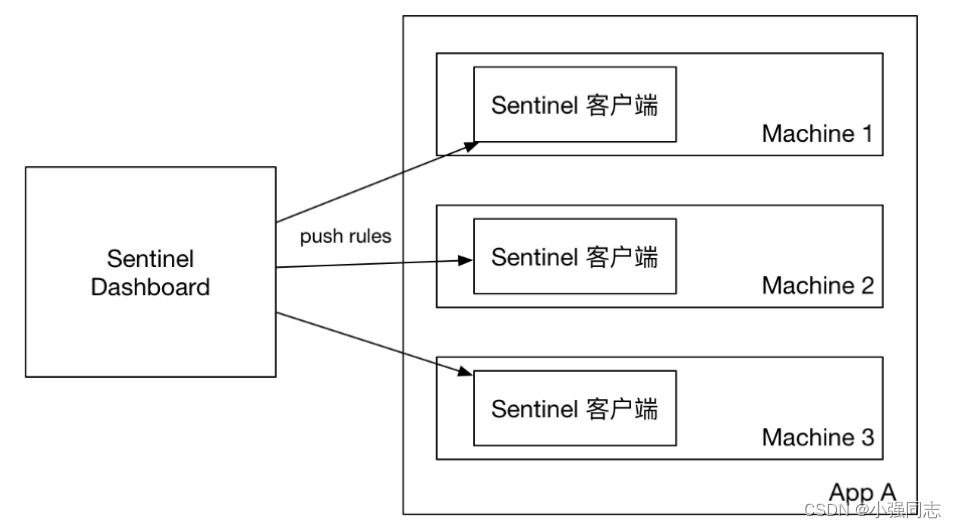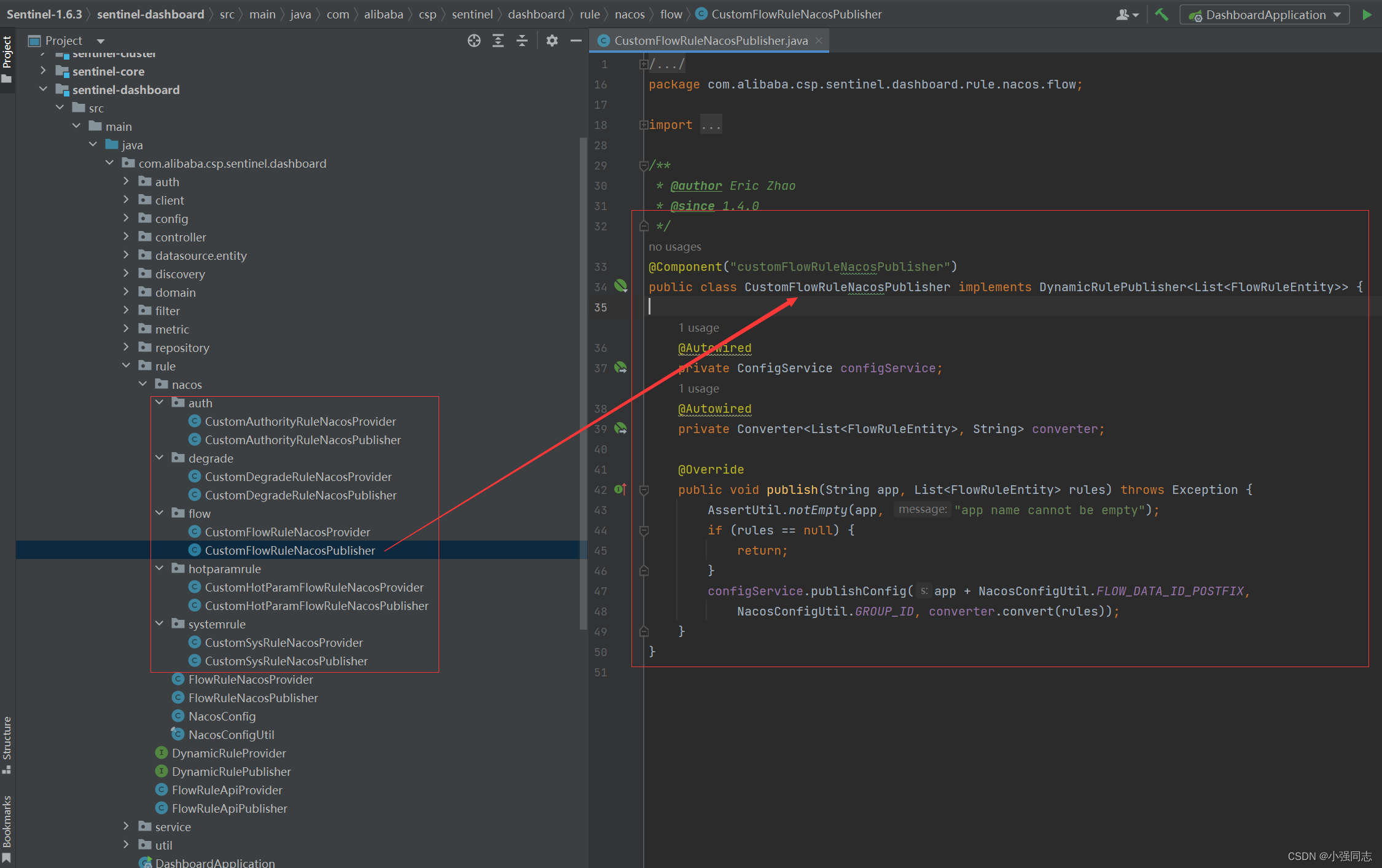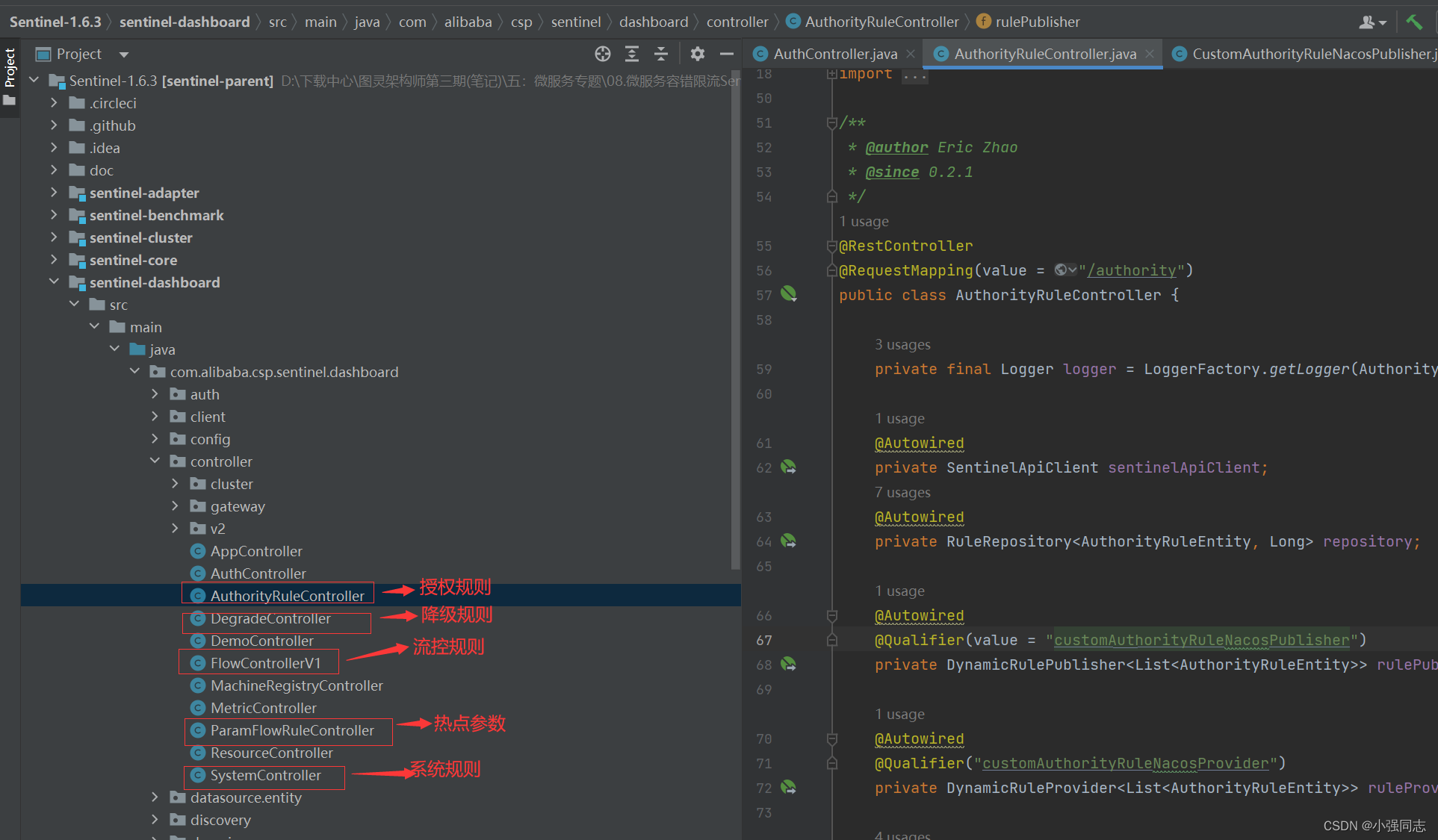我们知道我们的Sentinel-dashboard配置的规则,在我们的微服 务以及控制台重启的时候就清空了,因为他是基于内存的

原生模式
Dashboard的推送规则方式是通过 API 将规则推送至客户端并直接更新到内存

优缺点:这种做法的好处是简单,无依赖;坏处是应用重启规则就会消失,仅用 于简单测试,不能用于生产环境
Pull拉模式

首先 Sentinel 控制台通过 API 将规则推送至客户端并更新到内存中,接着注册 的写数据源会将新的规则保存到本地的文件中。使用 pull 模式的数据源时一般 不需要对 Sentinel 控制台进行改造。 这种实现方法好处是简单,不引入新的依赖,坏处是无法保证监控数据的一致性
客户端Sentinel的改造(拉模式)
通过SPI扩展机制进行扩展,我们写一个拉模式的实现类 com.demo.persistence.PullModeByFileDataSource,然后在工厂目录下创建
META-INF/services/com.alibaba.csp.sentinel.init.InitFunc文件

文件的内容就是写我们的拉模式的实现类:com.demo.persistence.PullModeByFileDataSource
推模式:push(已Nacos为例) 生产推荐使用

原理简述
- 控制台推送规则:
- 将规则推送到Nacos或其他远程配置中心 Sentinel客户端链接Nacos,获取规则配置;
- 并监听Nacos配 置变化,如发生变化,就更新本地缓存(从而让本地缓存总是和 Nacos一致)
微服务改造方案:
1.加入依赖
<dependency>
<groupId>com.alibaba.csp</groupId>
<artifactId>sentinel-datasource-nacos</artifactId>
</dependency>2.加入yml的配置
spring:
cloud:
nacos:
discovery:
server-addr: localhost:8848
sentinel:
transport:
dashboard: localhost:9999
#namespace: bc7613d2-2e22-4292-a748-48b78170f14c #指定namespace的id
datasource:
# 名称随意
flow:
nacos:
server-addr: localhost:8848
dataId: ${spring.application.name}-flow-rules
groupId: SENTINEL_GROUP
rule-type: flow
degrade:
nacos:
server-addr: localhost:8848
dataId: ${spring.application.name}-degrade-rules
groupId: SENTINEL_GROUP
rule-type: degrade
system:
nacos:
server-addr: localhost:8848
dataId: ${spring.application.name}-system-rules
groupId: SENTINEL_GROUP
rule-type: system
authority:
nacos:
server-addr: localhost:8848
dataId: ${spring.application.name}-authority-rules
groupId: SENTINEL_GROUP
rule-type: authority
param-flow:
nacos:
server-addr: localhost:8848
dataId: ${spring.application.name}-param-flow-rules
groupId: SENTINEL_GROUP
rule-type: param-flowSentinel-dashboard改造方案
//需要把test注释掉
<dependency>
<groupId>com.alibaba.csp</groupId>
<artifactId>sentinel‐datasource‐nacos</artifactId>
<!‐‐ <scope>test</scope>‐‐>
</dependency>控制台改造主要是为规则实现DynamicRuleProvider,DynamicRulePublisher
- DynamicRuleProvider:从Nacos上读取配置
- DynamicRulePublisher:将规则推送到Nacos上
参考码如下图:

在sentinel-dashboard工程目录com.alibaba.csp.sentinel.dashboard.rule 下创建一 个Nacos的包 然后把我们的各个场景的配置规则类写到该包下.


我们以ParamFlowRuleController(热点参数流控类作为修改作为演示)
@RestController
@RequestMapping(value = "/paramFlow")
public class ParamFlowRuleController {
private final Logger logger = LoggerFactory.getLogger(ParamFlowRuleController.class);
@Autowired
private SentinelApiClient sentinelApiClient;
@Autowired
private AppManagement appManagement;
@Autowired
private RuleRepository<ParamFlowRuleEntity, Long> repository;
@Autowired
@Qualifier("customHotParamFlowRuleNacosPublisher")
private DynamicRulePublisher<List<ParamFlowRuleEntity>> rulePublisher;
@Autowired
@Qualifier("customHotParamFlowRuleNacosProvider")
private DynamicRuleProvider<List<ParamFlowRuleEntity>> ruleProvider;
@Autowired
private AuthService<HttpServletRequest> authService;
private boolean checkIfSupported(String app, String ip, int port) {
try {
return Optional.ofNullable(appManagement.getDetailApp(app))
.flatMap(e -> e.getMachine(ip, port))
.flatMap(m -> VersionUtils.parseVersion(m.getVersion())
.map(v -> v.greaterOrEqual(version020)))
.orElse(true);
// If error occurred or cannot retrieve machine info, return true.
} catch (Exception ex) {
return true;
}
}
@GetMapping("/rules")
public Result<List<ParamFlowRuleEntity>> apiQueryAllRulesForMachine(HttpServletRequest request,
@RequestParam String app,
@RequestParam String ip,
@RequestParam Integer port) {
AuthUser authUser = authService.getAuthUser(request);
authUser.authTarget(app, PrivilegeType.READ_RULE);
if (StringUtil.isEmpty(app)) {
return Result.ofFail(-1, "app cannot be null or empty");
}
if (StringUtil.isEmpty(ip)) {
return Result.ofFail(-1, "ip cannot be null or empty");
}
if (port == null || port <= 0) {
return Result.ofFail(-1, "Invalid parameter: port");
}
if (!checkIfSupported(app, ip, port)) {
return unsupportedVersion();
}
try {
/* return sentinelApiClient.fetchParamFlowRulesOfMachine(app, ip, port)
.thenApply(repository::saveAll)
.thenApply(Result::ofSuccess)
.get();*/
List<ParamFlowRuleEntity> rules = ruleProvider.getRules(app);
rules = repository.saveAll(rules);
return Result.ofSuccess(rules);
} catch (ExecutionException ex) {
logger.error("Error when querying parameter flow rules", ex.getCause());
if (isNotSupported(ex.getCause())) {
return unsupportedVersion();
} else {
return Result.ofThrowable(-1, ex.getCause());
}
} catch (Throwable throwable) {
logger.error("Error when querying parameter flow rules", throwable);
return Result.ofFail(-1, throwable.getMessage());
}
}
private boolean isNotSupported(Throwable ex) {
return ex instanceof CommandNotFoundException;
}
@PostMapping("/rule")
public Result<ParamFlowRuleEntity> apiAddParamFlowRule(HttpServletRequest request,
@RequestBody ParamFlowRuleEntity entity) {
AuthUser authUser = authService.getAuthUser(request);
authUser.authTarget(entity.getApp(), PrivilegeType.WRITE_RULE);
Result<ParamFlowRuleEntity> checkResult = checkEntityInternal(entity);
if (checkResult != null) {
return checkResult;
}
if (!checkIfSupported(entity.getApp(), entity.getIp(), entity.getPort())) {
return unsupportedVersion();
}
entity.setId(null);
entity.getRule().setResource(entity.getResource().trim());
Date date = new Date();
entity.setGmtCreate(date);
entity.setGmtModified(date);
try {
entity = repository.save(entity);
//publishRules(entity.getApp(), entity.getIp(), entity.getPort()).get();
publishRules(entity.getApp());
return Result.ofSuccess(entity);
} catch (ExecutionException ex) {
logger.error("Error when adding new parameter flow rules", ex.getCause());
if (isNotSupported(ex.getCause())) {
return unsupportedVersion();
} else {
return Result.ofThrowable(-1, ex.getCause());
}
} catch (Throwable throwable) {
logger.error("Error when adding new parameter flow rules", throwable);
return Result.ofFail(-1, throwable.getMessage());
}
}
private <R> Result<R> checkEntityInternal(ParamFlowRuleEntity entity) {
if (entity == null) {
return Result.ofFail(-1, "bad rule body");
}
if (StringUtil.isBlank(entity.getApp())) {
return Result.ofFail(-1, "app can't be null or empty");
}
if (StringUtil.isBlank(entity.getIp())) {
return Result.ofFail(-1, "ip can't be null or empty");
}
if (entity.getPort() == null || entity.getPort() <= 0) {
return Result.ofFail(-1, "port can't be null");
}
if (entity.getRule() == null) {
return Result.ofFail(-1, "rule can't be null");
}
if (StringUtil.isBlank(entity.getResource())) {
return Result.ofFail(-1, "resource name cannot be null or empty");
}
if (entity.getCount() < 0) {
return Result.ofFail(-1, "count should be valid");
}
if (entity.getGrade() != RuleConstant.FLOW_GRADE_QPS) {
return Result.ofFail(-1, "Unknown mode (blockGrade) for parameter flow control");
}
if (entity.getParamIdx() == null || entity.getParamIdx() < 0) {
return Result.ofFail(-1, "paramIdx should be valid");
}
if (entity.getDurationInSec() <= 0) {
return Result.ofFail(-1, "durationInSec should be valid");
}
if (entity.getControlBehavior() < 0) {
return Result.ofFail(-1, "controlBehavior should be valid");
}
return null;
}
@PutMapping("/rule/{id}")
public Result<ParamFlowRuleEntity> apiUpdateParamFlowRule(HttpServletRequest request,
@PathVariable("id") Long id,
@RequestBody ParamFlowRuleEntity entity) {
AuthUser authUser = authService.getAuthUser(request);
if (id == null || id <= 0) {
return Result.ofFail(-1, "Invalid id");
}
ParamFlowRuleEntity oldEntity = repository.findById(id);
if (oldEntity == null) {
return Result.ofFail(-1, "id " + id + " does not exist");
}
authUser.authTarget(oldEntity.getApp(), PrivilegeType.WRITE_RULE);
Result<ParamFlowRuleEntity> checkResult = checkEntityInternal(entity);
if (checkResult != null) {
return checkResult;
}
if (!checkIfSupported(entity.getApp(), entity.getIp(), entity.getPort())) {
return unsupportedVersion();
}
entity.setId(id);
Date date = new Date();
entity.setGmtCreate(oldEntity.getGmtCreate());
entity.setGmtModified(date);
try {
entity = repository.save(entity);
//publishRules(entity.getApp(), entity.getIp(), entity.getPort()).get();
publishRules(entity.getApp());
return Result.ofSuccess(entity);
} catch (ExecutionException ex) {
logger.error("Error when updating parameter flow rules, id=" + id, ex.getCause());
if (isNotSupported(ex.getCause())) {
return unsupportedVersion();
} else {
return Result.ofThrowable(-1, ex.getCause());
}
} catch (Throwable throwable) {
logger.error("Error when updating parameter flow rules, id=" + id, throwable);
return Result.ofFail(-1, throwable.getMessage());
}
}
@DeleteMapping("/rule/{id}")
public Result<Long> apiDeleteRule(HttpServletRequest request, @PathVariable("id") Long id) {
AuthUser authUser = authService.getAuthUser(request);
if (id == null) {
return Result.ofFail(-1, "id cannot be null");
}
ParamFlowRuleEntity oldEntity = repository.findById(id);
if (oldEntity == null) {
return Result.ofSuccess(null);
}
authUser.authTarget(oldEntity.getApp(), PrivilegeType.DELETE_RULE);
try {
repository.delete(id);
/*publishRules(oldEntity.getApp(), oldEntity.getIp(), oldEntity.getPort()).get();*/
publishRules(oldEntity.getApp());
return Result.ofSuccess(id);
} catch (ExecutionException ex) {
logger.error("Error when deleting parameter flow rules", ex.getCause());
if (isNotSupported(ex.getCause())) {
return unsupportedVersion();
} else {
return Result.ofThrowable(-1, ex.getCause());
}
} catch (Throwable throwable) {
logger.error("Error when deleting parameter flow rules", throwable);
return Result.ofFail(-1, throwable.getMessage());
}
}
private CompletableFuture<Void> publishRules(String app, String ip, Integer port) {
List<ParamFlowRuleEntity> rules = repository.findAllByMachine(MachineInfo.of(app, ip, port));
return sentinelApiClient.setParamFlowRuleOfMachine(app, ip, port, rules);
}
private void publishRules(String app) throws Exception {
List<ParamFlowRuleEntity> rules = repository.findAllByApp(app);
rulePublisher.publish(app, rules);
}
private <R> Result<R> unsupportedVersion() {
return Result.ofFail(4041,
"Sentinel client not supported for parameter flow control (unsupported version or dependency absent)");
}
private final SentinelVersion version020 = new SentinelVersion().setMinorVersion(2);
}没有添加规则时,nacos的配置中心是如图

添加热点参数规则:(第一个入参的qps为100 统计时间为5s) 而针对的参数值为String类型 的 值为2的 流控为1
添加之后:


测试就会出现流控了,哈哈哈























 1万+
1万+











 被折叠的 条评论
为什么被折叠?
被折叠的 条评论
为什么被折叠?










